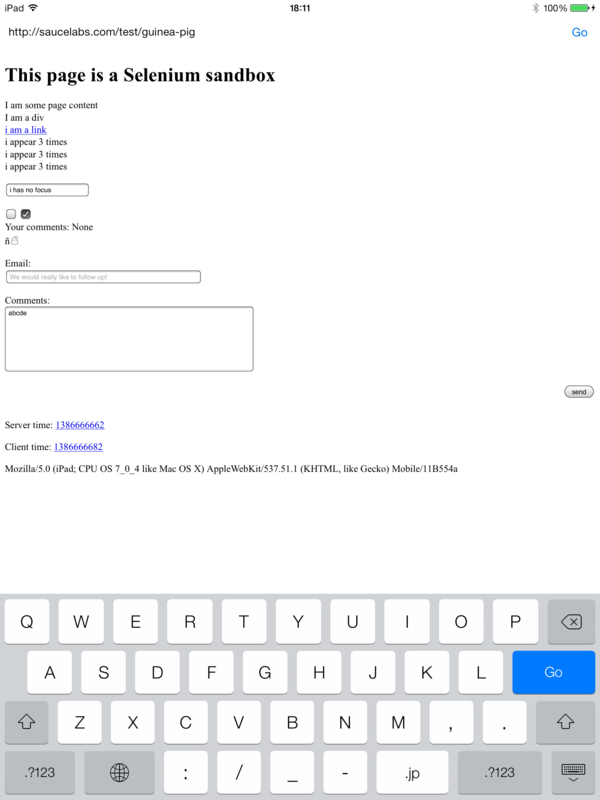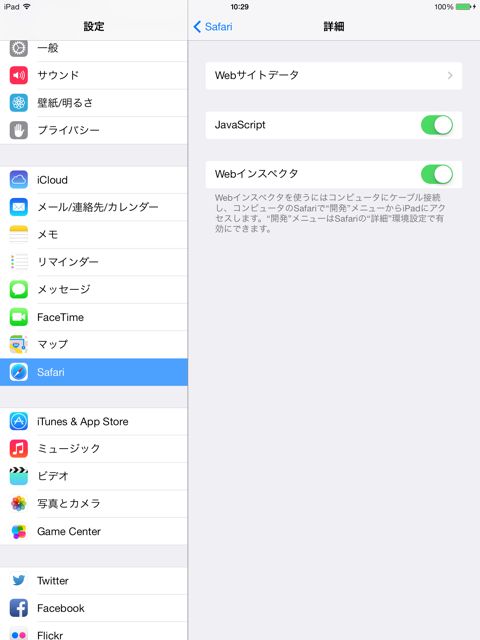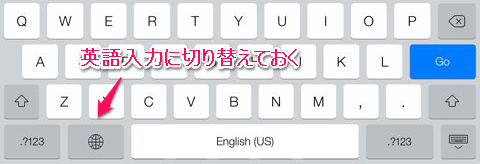【追記2014/7/7】
記事中のAppiumのドキュメントへのリンク先は削除されてしまったようです。その代わりに公式サイトのドキュメントが整備されています。
【追記2014/7/16】
Appiumの新しいバージョン(1.2.0)に関する記事を書きました。
こんにちは、間藤です。
Appiumによる自動テストの第3弾です。今回はハイブリットアプリの自動テストです。UIWebViewをいかにして操るのかということがポイントです。
実行環境等
テスト対象のアプリは、付属のサンプルを利用します。このアプリに対するJavaで書かれたテストが提供されていないようなので、今回は自作しました。
| ホストPC | OS X Mavericks |
| Xcode | 5.0.2 |
| Appium | 0.12.0 |
| iOSシミュレータ | 7.0.3 |
| iOS実機 | 7.0.4 |
| テスト対象アプリ | sample-code/apps/WebViewApp |
| テストスクリプト | 自作します |
テスト対象となるアプリ
URLを入力するためのUITextField、入力したURLへのリクエストを実行するためのUIButton、結果を表示するUIWebViewという構成のアプリです。

テストスクリプト
テストスクリプトはAppiumのドキュメントを参考にして作成しました。
package jp.co.iti.appium; import java.io.File; import java.net.URL; import java.util.concurrent.TimeUnit; import org.junit.After; import org.junit.Before; import org.junit.Test; import static org.junit.Assert.assertEquals; import org.apache.commons.io.FileUtils; import org.openqa.selenium.By; import org.openqa.selenium.WebDriver; import org.openqa.selenium.WebElement; import org.openqa.selenium.remote.CapabilityType; import org.openqa.selenium.remote.DesiredCapabilities; import org.openqa.selenium.remote.RemoteWebDriver; import org.openqa.selenium.TakesScreenshot; import org.openqa.selenium.OutputType; import org.openqa.selenium.remote.Augmenter; public class SimpleWebViewTest { private WebDriver driver; @Before public void setUp() throws Exception { // set up appium File appDir = new File(System.getProperty("user.dir"), "../../../apps/WebViewApp/build/Release-iphonesimulator"); File app = new File(appDir, "WebViewApp.app"); DesiredCapabilities capabilities = new DesiredCapabilities(); capabilities.setCapability(CapabilityType.BROWSER_NAME, ""); capabilities.setCapability(CapabilityType.VERSION, "6.0"); capabilities.setCapability(CapabilityType.PLATFORM, "Mac"); capabilities.setCapability("device", "iPad Simulator"); capabilities.setCapability("app", app.getAbsolutePath()); driver = new RemoteWebDriver(new URL("http://127.0.0.1:4723/wd/hub"), capabilities); Augmenter augmenter = new Augmenter(); driver = augmenter.augment(driver); } @After public void tearDown() throws Exception { driver.quit(); } private void getScreenshotAs(String path) { TakesScreenshot ts = (TakesScreenshot) driver; try { FileUtils.copyFile( ts.getScreenshotAs(OutputType.FILE), new File(path)); } catch (Exception e) { e.printStackTrace(); } } @Test public void testUIComputation() throws Exception { // ページロードのタイミングをはかるための措置 driver.manage().timeouts().implicitlyWait(30, TimeUnit.SECONDS); // テキストにURLを入力 WebElement text = driver.findElement(By.tagName("textField")); String url = "http://saucelabs.com/test/guinea-pig"; text.sendKeys(url); // GOボタンをクリック driver.findElement(By.tagName("button")).click(); // WebViewに切替 for(String winHandle : driver.getWindowHandles()){ driver.switchTo().window(winHandle); } // 遷移したWebページの検査 WebElement div = driver.findElement(By.id("i_am_an_id")); assertEquals("I am a div", div.getText()); // Webページ上のDOM要素の値を変更 driver.findElement(By.id("comments")).sendKeys("My comment"); // キャプチャをとる getScreenshotAs("capture_webviewtest.jpg"); } }
ネイティブアプリ編との一番の違いは、UIWebViewに対する制御です。ハイブリッドアプリの場合、WebViewに表示しているDOM要素を操作したいので、コンテキスト(?)を切り替える処理を行っています。
for(String winHandle : driver.getWindowHandles()){
driver.switchTo().window(winHandle);
}
ループを回していることに違和感を覚えるのですが、Appiumのドキュメントに掲載されていたサンプルコードを参考にしたものです。この切替ができれば、それ以降のDriverに対する操作(findElement等)は、WebViewに対して行われるので、JavaScriptでDOM要素を制御する感覚でテストを書けます。
この他のポイントとしては、非同期処理の待機を行っていることです。DOM要素を操作する前提として、WebViewがページロードを終えていなければなりません。以下の処理を実行したとき、ページロードが終わっていないと、テストがエラーとなってしまいます。
WebElement div = driver.findElement(By.id("i_am_an_id"));
Thread.sleep()などで、待機処理を自分で書くこともできますが、以下のようにimplicitlyWait()メソッドを使うことで、簡単に待機処理を実現できます。
driver.manage().timeouts().implicitlyWait(30, TimeUnit.SECONDS);
こうしておくと要素が取得できるまで最大30秒間待機してくれます。
事前準備
テスト実施の前にいくつか準備が必要です。
まず、Mobile Safariの設定を確認し、Webインスペクタ設定をオンにしてください。(シミュレータも同様です。)

UIWebViewに対する操作は、SafariのWebインスペクタを利用するようです。
次に、こちらのドキュメントを参考にして、ios-webkit-debugger-proxyをインストールしてください。実機でテストする場合、ios-webkit-debugger-proxyを経由してUIWebViewに対する操作を行う仕組みになっています。シミュレータの場合、ios-webkit-debugger-proxyは必要ありません。
シミュレータで実行
まず、Appiumサーバを起動します。
> appium
そして、テストを実行します。
> cd sample-code/examples/java/junit > mvn test -Dtest=jp.co.iti.appium.SimpleWebViewTest
実機で実行
実機で実行する場合は、ios-webkit-debugger-proxyを起動しておきます。
> ios_webkit_debug_proxy -c (実機のUDID):27753
パラメータにポート番号を指定していることに注意してください。Appiumはこのポートに接続してくるようになっています。
Appiumサーバを起動します。
> appium -U (実機のUDID)
そして、テストを実行します。
> mvn test -Dtest=jp.co.iti.appium.SimpleWebViewTest
トラブルシューティング
今回のテストシナリオでは、最初にURLを入力しています。この際、日本語入力として解釈されてしまうと、以下のように出鱈目な入力になってしまい、テストが正常に動きません。

これを回避するため、テスト実施前にキーボードを英語入力に切り替えておきます。

ただ、テストシナリオの途中で切り替えたいこともあるでしょう。やや無理やりな感はありますが、以下ようにすると、入力切替のボタン押下をシミュレートできました。
WebElement text = driver.findElement(By.tagName("textField")); text.click(); WebElement button = driver.findElement(By.name("Next keyboard")); button.click();
最初にテキストフィールドをクリックしているのは、キーボードが表示されるようにするためです。なお、対象ボタンのname属性を調べるため、私はまず以下のようなプログラムで確認を行いました。
List<WebElement> elems = driver.findElements(By.tagName("button")); System.out.println("-----"); for (WebElement elem : elems) { System.out.println("[atr]" + elem.getAttribute("name")); } System.out.println("-----");
次回は、「Mobile Safari編」を投稿します。